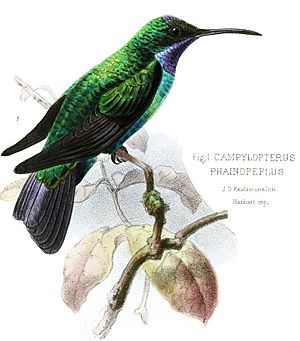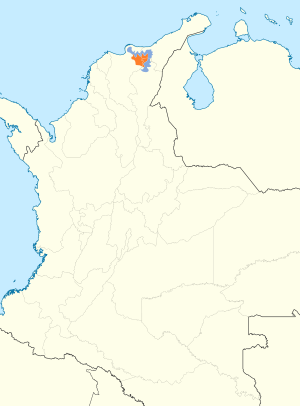Santa Marta sabrewing facts for kids
Quick facts for kids Santa Marta sabrewing |
|
|---|---|
 |
|
| A male, illustrated by J. G. Keulemans. | |
| Conservation status | |
| Scientific classification | |
| Genus: |
Campylopterus
|
| Species: |
phainopeplus
|
 |
|
The Santa Marta sabrewing (scientific name: Campylopterus phainopeplus) is a special type of hummingbird. It is known as a "sabrewing" because of its long, curved beak. This bird is found only in one place: the Sierra Nevada de Santa Marta mountains in northeastern Colombia. It is one of 24 bird species that live only in these mountains. Sadly, this hummingbird is now considered a Critically Endangered species, meaning it is at very high risk of disappearing forever.
Contents
What is the Santa Marta Sabrewing?
The Santa Marta sabrewing is about 13 centimeters (5.1 inches) long. Both male and female sabrewings have a black beak that curves downwards. They also have a small white spot right behind each eye.
How to Identify Male and Female Sabrewings
Male sabrewings are very colorful. Their upper body is a shiny emerald green. They have a black face, and their throat and chest shimmer with an iridescent blue color. The rest of their underside is dark green. Their tail feathers are a dark, shiny blue, like steel.
Female sabrewings are also beautiful, but a bit less colorful than the males. Their upper body is a shining green. Their underside is mostly grayish-white, with green feathers on their sides and under their tail. Their tail is mostly green, but the feathers on the very outside have grayish tips.
Where Does the Santa Marta Sabrewing Live?
The Santa Marta sabrewing lives only in the isolated Sierra Nevada de Santa Marta mountains in northeastern Colombia. This area is like an island of mountains surrounded by lower lands.
What is the Sabrewing's Habitat?
These hummingbirds prefer to live at the edges of humid forests. They can also be found in plantations, especially banana farms, and in bushy areas called páramo. They live at elevations from 1,200 meters (3,900 feet) up to 2,400 meters (7,900 feet) above sea level.
How Does the Santa Marta Sabrewing Live?
Seasonal Movements of the Sabrewing
The Santa Marta sabrewing moves to different elevations depending on the season. During the dry season, from February to May, they stay below 1,800 meters (5,900 feet). When the wet season arrives, from June to October, they move higher up the mountains, sometimes even close to the snow line.
What Does the Sabrewing Eat?
Scientists do not know much about what the Santa Marta sabrewing eats or how it finds its food. We do know that it feeds on the flowers of banana plants (Musa). These birds are also known to be territorial, meaning they protect their feeding areas from other birds.
Reproduction and Life Cycle
Scientists have found Santa Marta sabrewings ready to breed between April and June. Males have been seen performing special displays to attract females in June and July. However, not much else is known about how they reproduce. No one has ever described their nest.
How Does the Sabrewing Communicate?
As of mid-2022, only one recording of the Santa Marta sabrewing's voice exists. It makes a sad-sounding, double "twit-twit" sound. It makes this sound both when it is flying and when it is performing its display.
Why is the Santa Marta Sabrewing Endangered?
The IUCN (International Union for Conservation of Nature) first listed the Santa Marta sabrewing as "Near Threatened." Then, in 2000, it became "Endangered." Since 2020, it has been listed as "Critically Endangered." This means it is very close to extinction.
Threats to the Sabrewing's Survival
The main reasons this bird is in danger are:
- Small Population: There are thought to be fewer than 50 adult sabrewings left.
- Habitat Loss: About 85% of the original forests where it lives have been destroyed. This is because people cut down trees for wood, turn land into farms or pastures for animals, and build homes.
- Fragmented Habitat: The remaining forests are broken up into small pieces, making it harder for the birds to find food and mates.
- Climate Change: Changes in weather patterns are making the dry season longer. This increases the risk of wildfires, which can destroy the sabrewing's habitat.
Rediscovery of the Sabrewing
Around the year 1900, the Santa Marta sabrewing was thought to be quite common. It was seen off and on until 1946. After that, it was not seen again for a very long time. In 2010, it was recorded again, but then it was "lost" once more. Finally, in 2022, its survival was confirmed by a photograph of a male bird, which was found by chance. This rediscovery gave hope for the species.
Images for kids
See also
 In Spanish: Ala de sable serrano para niños
In Spanish: Ala de sable serrano para niños



